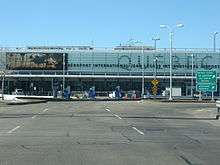Québec City Jean Lesage International Airport
| Québec City Jean Lesage International Airport Aéroport international Jean-Lesage de Québec Jean Lesage International Airport | |||||||||||||||
|---|---|---|---|---|---|---|---|---|---|---|---|---|---|---|---|
 | |||||||||||||||
 | |||||||||||||||
|
IATA: YQB – ICAO: CYQB – WMO: 71708 | |||||||||||||||
| Summary | |||||||||||||||
| Airport type | Public/Military | ||||||||||||||
| Owner | Transport Canada | ||||||||||||||
| Operator | Aéroport de Québec Inc. | ||||||||||||||
| Serves | Quebec City, Quebec | ||||||||||||||
| Location | Sainte-Foy, Quebec | ||||||||||||||
| Time zone | EST (UTC−05:00) | ||||||||||||||
| • Summer (DST) | EDT (UTC−04:00) | ||||||||||||||
| Elevation AMSL | 244 ft / 74 m | ||||||||||||||
| Coordinates | 46°47′28″N 071°23′36″W / 46.79111°N 71.39333°WCoordinates: 46°47′28″N 071°23′36″W / 46.79111°N 71.39333°W | ||||||||||||||
| Website | www.aeroportdequebec.com | ||||||||||||||
| Map | |||||||||||||||
 CYQB | |||||||||||||||
| Runways | |||||||||||||||
| |||||||||||||||
| Statistics (2014/2015) | |||||||||||||||
| |||||||||||||||
|
Sources: Canada Flight Supplement[1] Environment Canada[2] Movements from Statistics Canada[3] Passenger statistics from Aéroport de Québec.[4] | |||||||||||||||
Québec City Jean Lesage International Airport, also known as Jean Lesage International Airport (French: Aéroport international Jean-Lesage de Québec, or Aéroport de Québec) (IATA: YQB, ICAO: CYQB) was established in 1939, a year after the closure of the Aérodrome Saint-Louis. It is located 6 nautical miles (11 km; 6.9 mi) west southwest of Quebec City, Quebec, Canada. First established as a training facility for air observers, the first flight occurred on September 11, 1941. It is the second busiest passenger airport in Quebec after Montreal-Trudeau airport and the third busiest airport by aircraft movements in Quebec after Montreal-Trudeau and Montreal-Saint-Hubert, with 1,584,713 passengers[4] in 2015 and 112,468 aircraft movements in 2014.[3]
First known as the Aéroport de l'Ancienne Lorette, then the Aéroport de Sainte-Foy, and later the Aéroport de Québec, it was renamed to Aéroport international Jean-Lesage in 1993, in honour of the former Premier of Quebec, Jean Lesage.
The airport is managed and operated by Aéroport de Québec inc., a non-profit and non-share corporation. The current terminal building has a capacity of 1.4 million passengers annually.[5]
In 2010, 2011 and 2013, the airport was voted Best Regional Airport in North America by Airports Council International's Airport Service Quality (ASQ) program.[6][7]
On September 19, 2013, runway 12/30 was renamed to runway 11/29.
Public transportation to the airport is provided by RTC bus 78 a few times a day.
Airport expansion

Beginning in 2006, with a budget of $65.8 million, Québec/Jean Lesage International Airport underwent a modernization designed to increase the terminal's capacity and substantially enhance the level of passenger service. The modernization included a reconfiguration of the terminal on 2 levels, a restructuring of the baggage handling area and arrivals area, as well as a reconfiguration and enlargement of the waiting rooms. 54% of the financing was provided directly by Aéroport de Québec inc. Completed in June 2008, the new configuration of the airport now enables it to handle 1.4 million passengers a year.
Based on the passenger figures for 2009 and 2010, it became clear that the terminal building would reach its design capacity by 2012. Aéroport de Québec inc. is therefore planning further investments of nearly $300 million to further expand the terminal building.[5] Presently the terminal has 13 gates: 8 contact gates and 5 walk-out aircraft positions. This number will increase to 16 gates by 2017, and 24 by 2025.[8]
On July 4, 2011, work began on the second phase of the airport expansion, which will last until 2017. The terminal building will double in size, at a cost of $224.8 million. The work will include an expansion of the international facilities, construction work on the runways, taxiways and de-icing pads, as well as enhancements to customer service facilities.[9]
Airlines and destinations
Over 10 airlines offer 360 weekly flights from Jean Lesage International Airport to destinations across Eastern Canada, the United States, Central America, Mexico, the Caribbean and Europe.
Cargo
| Airlines | Destinations |
|---|---|
| FedEx Feeder operated by Morningstar Air Express | Montreal-Mirabel |
| SkyLink Express | Montreal-Mirabel |
| Glencore | Kattiniq/Donaldson |
Statistics
In 2014 the airport was the 13th busiest airport by total passengers and 14th busiest by aircraft movements in Canada.[10]
| Year | Total passengersA | Aircraft Movements |
|---|---|---|
| 2000 | 672,829 | 142,612 |
| 2001 | 642,767 | 151,650 |
| 2002 | 610,568 | 135,646 |
| 2003 | 628,545 | 116,523 |
| 2004 | 715,106 | 109,180 |
| 2005 | 793,735 | 101,367 |
| 2006 | 802,263 | 109,031 |
| 2007 | 899,612 | 119,441 |
| 2008 | 1,022,862 | 125,512 |
| 2009 | 1,035,026 | 128,890 |
| 2010 | 1,190,088 | 126,856 |
| 2011 | 1,313,432 | 128,748 |
| 2012 | 1,342,840 | 133,675 |
| 2013 | 1,475,717 | 118,265 |
| 2014 | 1,574,699 | 112,468 |
| 2015 | 1,584,713 |
- ^A Statistics prior to 2009 are from Transport Canada. From 2009 on statistics are from Aéroport de Québec (ADQ). Transport Canada's statistics are consistently higher than those of ADQ.
Fire and rescue
The airport's fire department has a crew of 20 using 6 different pieces of equipment to deal with emergencies at the airport.[15]
Accidents and incidents
- On 9 September 1949, Canadian Pacific Airlines Flight 108 on a flight from Montreal to Baie-Comeau with a stopover in Quebec City crash-landed east of Quebec City when a bomb exploded on-board shortly after departing from Quebec City Jean Lesage Airport (then known as L'Ancienne-Lorette Airport), killing all 19 passengers and 4 crews. The incident and trial that followed up would be later known as the Albert Guay affair.
- On 29 March 1979, Québecair Flight 255, a Fairchild F-27, crashed after take-off killing 17 and injuring 7.
- On 23 June 2010, a Beechcraft A100 King Air of Aeropro crashed after taking off from Québec City Jean Lesage International Airport, killing all seven people on board.[16]
See also
References
- ↑ Canada Flight Supplement. Effective 0901Z 24 July 2014 to 0901Z 18 September 2014
- ↑ Synoptic/Metstat Station Information
- 1 2 3 Total aircraft movements by class of operation — NAV CANADA towers
- 1 2 3 Aéroport de Québec - Statistics
- 1 2 Le Soleil (8 November 2010). "L'aéroport de Québec trop petit d'ici deux ans" (in French). Cyberpresse.ca. Retrieved 11 November 2010.
- ↑ ASQ Awards - Past Winners 2010
- ↑ ASQ Awards - Industry Recognition Of The Best Airports In The World
- ↑ Aéroport de Québec Master Plan
- ↑ La Presse (4 July 2011). "L'aéroport de Québec s'agrandit (french)". Cyberpresse.ca. Retrieved 4 July 2011.
- 1 2 Total aircraft movements by class of operation — NAV CANADA towers
- ↑ Top 100 Airports Ranked by Enplaned and Deplaned Passengers, Selected Services or Passengers enplaned and deplaned on selected services — Top 50 airports, 2001, 2002, 2004, 2006, 2007
- ↑ Passengers enplaned and deplaned on selected services — Top 50 airports 2008
- ↑ Total aircraft movements by class of operation — NAV CANADA towers
- ↑ TP577 - Aircraft Movement Statistics Annual Report. Transport Canada 2004
- ↑ http://www.aeroportdequebec.com/en/passenger/safety-security/fire-department/
- ↑ CBC News (23 June 2010). "Quebec City plane crash cause unclear". Canadian Broadcasting Corporation. Retrieved 25 June 2010.
External links
- Past three hours METARs, SPECI and current TAFs for Québec/Jean Lesage International Airport from Nav Canada as available.
| ||||||||||||||||||||||||||||||
| |||||||||||||||||||||||||
